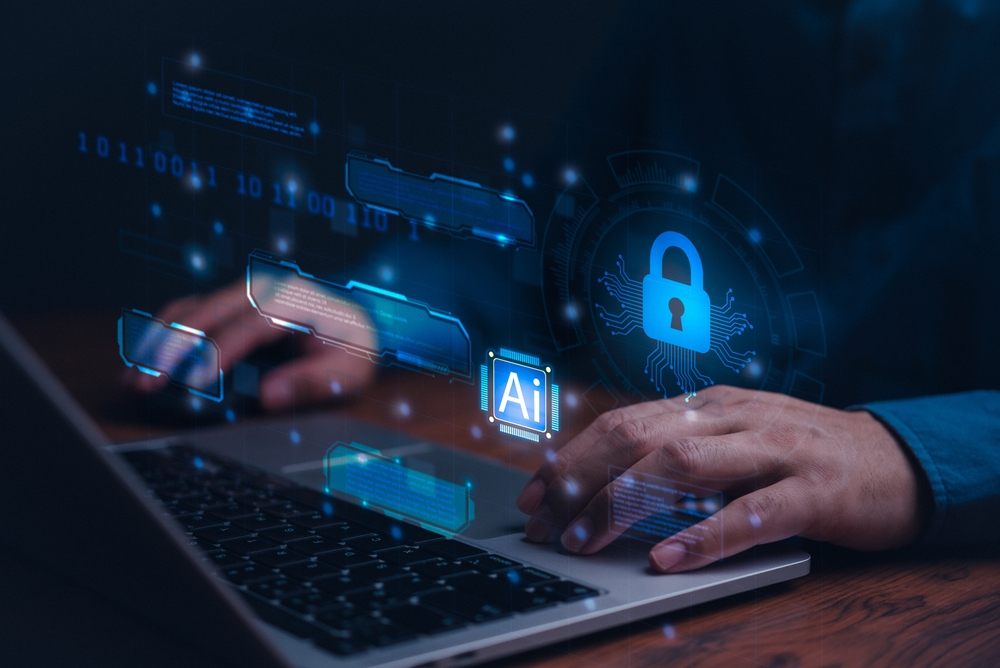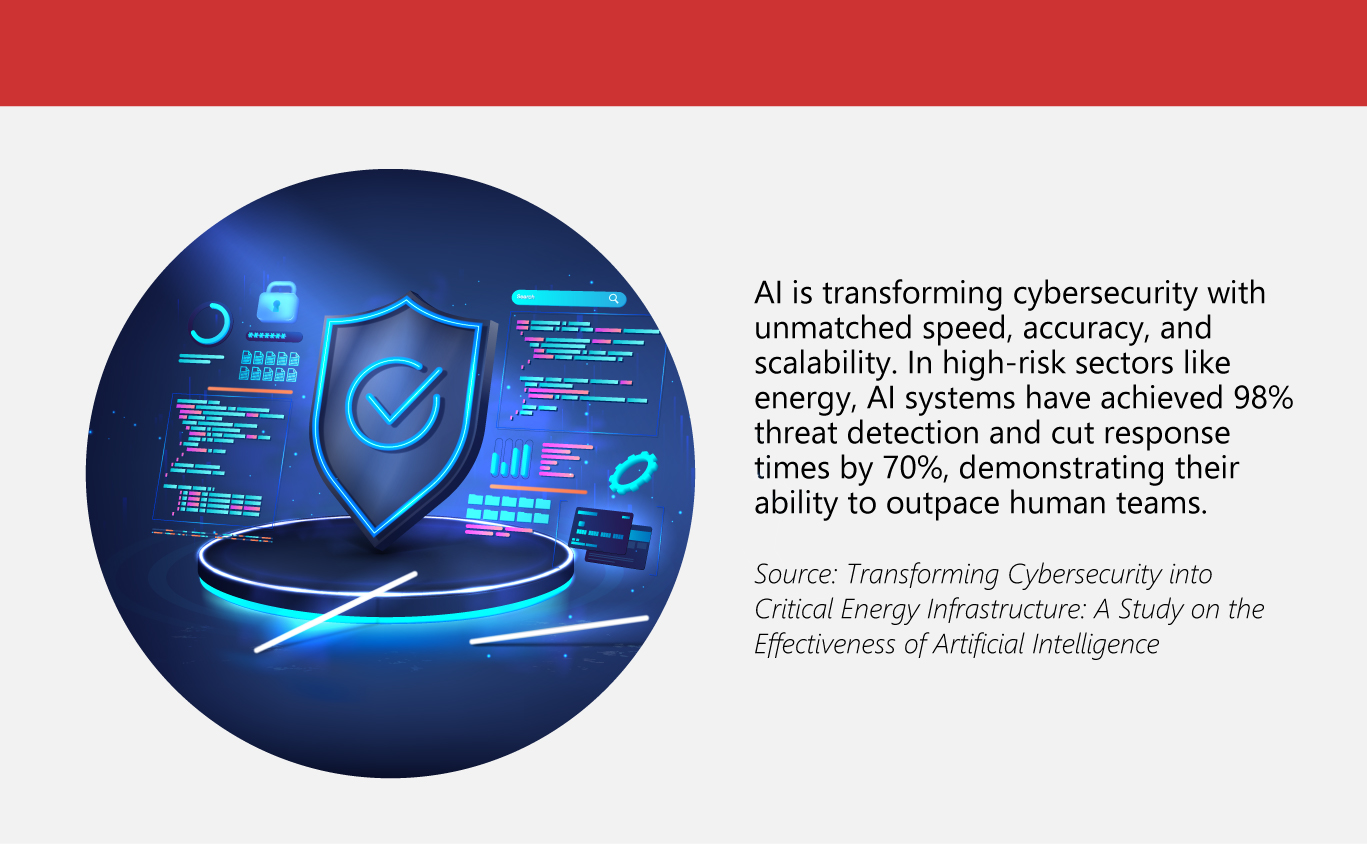AI Can Improve Cybersecurity in 10 Ways

Global manufacturing is racing to adopt artificial intelligence (AI), but rushing invites risk. While new AI tools can strengthen security, they also introduce fresh vulnerabilities. Today’s threat landscape is more complex than ever, with Microsoft’s tracked attackers surging from 300 to over 1,500 in a year. State-backed campaigns and fast-moving ransomware add to the pressure, and breaches can occur within just 72 minutes of a single bad click, making smarter, resilient AI-driven defenses essential.
AI may be built on statistics and data analytics, but the real measure of a company’s capabilities is how it turns those insights into meaningful action. As organizations race to become future-ready, a serious security question looms: where that information flows, how it’s exposed, and whether its use creates new safety risks that demand attention.
In manufacturing industries, AI is reshaping cybersecurity from the ground up. Instead of relying on manual monitoring, smart systems now sift through massive data streams, spot threats earlier, trigger quicker responses, and sharpen decision-making. The result is a faster, smarter, more resilient layer of protection built for modern industrial risks.
The Global Cybersecurity Outlook 2025 shows a striking gap: while two-thirds of organizations anticipate AI will reshape cybersecurity within the year, barely a third have mechanisms in place to assess the security of those AI tools before they go live.
When AI becomes part of system integration, the stakes rise quickly. Poorly secured models can be twisted, breached, or fed tainted data, triggering costly disruptions and long-term reputational fallout. Protecting the sensitive information that powers these systems means treating cybersecurity as a built-in requirement, from data pipelines to access controls, ensuring AI is deployed with resilience rather than risk.
AI-powered cybersecurity draws on a set of advanced technologies to stay ahead of attackers and improve operational efficiency. Machine learning flags suspicious patterns by learning from past incidents, while deep learning sifts through complex data to uncover harder-to-spot anomalies. Even natural language processing plays a role, scanning emails and messages for signs of phishing or hidden threat cues.
(Also read: Why You Should Use AI for Improving Factories)
10 ways AI reinforces cybersecurity
In the battle against cyber threats, AI acts as a vigilant digital guard. It conducts a thorough analysis to detect unusual activity, assesses the severity of potential attacks, blocks threats before they spread, and speeds system recovery. Every incident teaches the system, making defenses smarter and more proactive over time.
- Total coverage
Regardless of where they stand in AI adoption, organizations should address cyber risks to achieve manufacturing excellence. By mapping implementations, applying Zero Trust principles, and using AI to monitor behavior, businesses can embed security by design.
- Quick threat response
Enhance reliability testing by integrating generative AI with Extended Detection and Response (XDR). Use exposure management and advanced analytics to detect, investigate, and prevent threats, ensuring systems remain secure and resilient.
- Clear verification
AI-driven biometric authentication, combined with phishing-resistant protocols like multi-factor authentication, reduces reliance on passwords. Continuous testing of permissions and decommissioning unused applications helps ensure the identity infrastructure remains secure, resilient, and reliable over time.
- Proactive protection
Testing solutions that simulate real-world attacks allows organizations to uncover vulnerabilities early and strengthen AI defenses. By evaluating which AI applications are in use, businesses can ensure systems remain secure, private, and trustworthy.
- Boosted data security
By using AI to automatically classify and secure sensitive information across environments, and combining it with insider risk management tools, organizations can detect unusual behavior and prevent misuse before it escalates.
- Constant vigilance
While AI strengthens data protection, employees play a crucial role in security. Regularly clearing browsing history, cookies, and site data, and avoiding sensitive transactions on unsecured websites, helps reduce risk and reinforces overall organizational cybersecurity.
- Optimized systems
Keeping operating systems, applications, and firmware up to date is essential to block known vulnerabilities. AI can automate patch management, predict which systems are most at risk, and prioritize updates to strengthen protection.
- Digital risk awareness
AI enhances digital environmental awareness by monitoring networks and devices in real time. It can filter phishing and spam, block malicious content, and secure mobile devices. With real-time response, AI reduces potential breaches and limits operational disruptions.
- Industry collaboration
Cybersecurity is a team effort. By sharing threat intelligence and leveraging AI-driven platforms, organizations can integrate AI systems into broader governance and risk management, reducing potential impacts and strengthening enterprise-wide defenses.
- Continuous learning
Effective cybersecurity begins with informed teams. Using AI to train and upskill employees, alongside collaboration with experts, regulators, and policymakers, helps address AI-driven vulnerabilities, promote accountability, and build trust while enabling secure, confident innovation.
(Also read: 7 Reasons to Use AI in Printing)

What’s Next for AI in Cybersecurity
The latest news in the manufacturing industry often highlights AI, and its growing role in cybersecurity promises faster responses, stronger privacy protections, and readiness for emerging digital threats. Some trends include:
- Automated threat response
Autonomous response systems are transforming cybersecurity by allowing AI to act instantly, cutting access as threats emerge.
In high-stakes scenarios like ransomware attacks, this speed minimizes potential damage. Companies leveraging AI-driven security have saved an average of $1.9 million compared to those without it. Far from replacing human teams, these systems enhance them, freeing staff to focus on strategic priorities.
For the manufacturing sector, integrating such AI strengthens overall manufacturing capabilities and operational resilience.
- Privacy-focused federated learning
Federated learning is emerging as a key approach to privacy-preserving AI. By training models across decentralized data sources without moving sensitive information, organizations can harness AI insights while keeping data secure. This method minimizes exposure to breaches and regulatory risk, allowing multiple teams or sites to contribute to AI development safely.
For manufacturing industries, federated learning not only protects proprietary data but also enhances collaboration, enabling smarter AI applications without compromising privacy or operational integrity.
- AI-powered quantum security
Quantum computing remains in its infancy, but its potential to crack current encryption methods has cybersecurity experts racing to develop quantum-resistant cryptography. AI is playing a pivotal role, analyzing how quantum systems could exploit existing weaknesses and helping researchers design stronger, future-proof security measures.
By simulating potential attacks and testing new cryptographic approaches, AI accelerates the development of encryption that can withstand quantum-level threats, ensuring that sensitive data and critical systems remain secure as quantum technology advances.
- Bridging the talent gap
The cybersecurity sector faces a global talent shortage, with 4.8 million professionals needed. AI helps bridge this gap by easing complex tasks and lowering entry barriers for newcomers, strengthening overall security.
Regions like South America face unique challenges, where demand for certified cybersecurity experts is rising. According to the Organization for Economic Cooperation and Development (OECD)-backed study Building a Skilled Cyber Security Workforce in Latin America, required certifications demand significant expertise, highlighting both the urgency and opportunity to develop skilled professionals while leveraging AI to support and empower human teams.
Balancing AI automation with human oversight
Full automation in cybersecurity offers speed and efficiency, but it comes with limitations. AI relies on the quality of its training data, and changing patterns can lead to missed threats or false alarms. Over-automation also risks critical errors, from blocked users to disrupted operations, if decisions are made without human judgment.
The most effective approach blends AI and human expertise. AI handles routine monitoring, anomaly detection, and rapid responses, while human analysts focus on complex threats, context, and nuanced decisions that machines cannot fully replicate.
As one of the Top 20 EMS companies in the world, IMI has over 40 years of experience in providing electronics manufacturing and technology solutions.
We are ready to support your business on a global scale.
Our proven technical expertise, worldwide reach, and vast experience in high-growth and emerging markets make us the ideal global manufacturing solutions partner.
Let's work together to build our future today.
Other Blog




